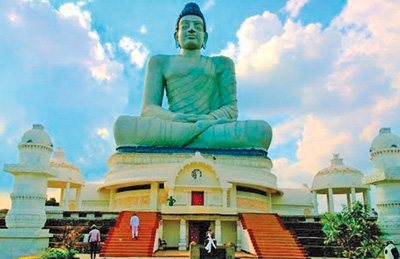Sunday Times 2
Queen Srimala in Ban’s Vesak message: She embodied women empowerment
As Theravada Buddhism is firmly established in Sri Lanka, the Sutra of Srimala, which has significantly contributed to early Mahayana Scriptures, may be unfamiliar to Lankan Buddhists.
The role Srimala played is given in “The Queen Srimala Sutra” and as UN Secretary General Ban-Ki-Moon said in his Vesak Message last week, it relates the story of a woman who pledged to help those suffering from injustice, illness, poverty or disaster. It illustrates the primary role a woman can play in advocating peace, justice and human rights. It assumes added significance because gender-equality and the empowerment of women remain urgent priorities on the UN agenda. Srimala portrayed the dignity and wisdom of a lay woman and her Sutra or theory is hailed as a unique development within the Buddhist tradition because of its egalitarian and generous view concerning women.

The Amaravati stupa in Andhra Pradesh, the region from where Srimala Sutra spread to China through Korea. Pic courtesy indianeagle.com
About 200-300 years after the passing away of the Buddha, two major groups emerged among his followers. The first group followed the way of the Elders. It was called Hinayana, also known as Theravada Buddhism which concentrated on freeing oneself from the samsaric cycle through the development of mind. This form of Buddhism, as the Buddha preached, arrived in Sri Lanka in 236 BCE and it spread to Myanmar, Thailand, Laos and Cambodia.
The other group was Mahayana which believed in achieving Nirvana through a life of good work for others. It gained popularity in Tibet, China, Mongolia, Japan, Korea, Vietnam and Nepal. The Korean-born UN Secretary General Ban may be well conversant with the story of Srimala as he hails from a part of the world where Mahayana has taken root.
Queen Srimala who had figured prominently in Mahayana Buddhism, was the daughter of King Prasenjit and Queen Mallika of the ancient Kosala kingdom. They had just embraced Buddhism and met the Buddha at Jethavanarama of Anathapindika’s park in Sravasthi when they informed him of their daughter Queen Srimala who was staying in the kingdom of Ayodhya. Her parents told him that she was wise, intelligent and would understand well the Buddha’s teachings and expressed the wish that she meets the Buddha.
She met with the Buddha and the Sutra writes of many miracles which had taken place during the meeting. She listened to the Buddha and, according to the text of The Queen Srimala Sutra, was empowered by the Buddha to teach the Dhamma. Her Sutra affirms that the Dhammakaaya of the Buddha has the perfection of permanence, the perfection of pleasure, self, purity. Whoever sees the Dhammakaaya of the Thathagatha that way, sees correctly. Her theory caught on as she as a lay woman, played the role of a woman philosopher and teacher. The philosophical emphasis of the text was the theory of the “Tathagatha Garbha” or womb of the Buddha and ‘Eka Yaana’ or One Vehicle which followed the Buddha-nature doctrine. And the Sutra states that at the time of the Buddha, female seekers were equal to men.
The Srimala Sutra, one of the main early Mahayana Buddhist texts became the primary scriptural advocates in India for the universal potentiality of Buddhahood.
According to Brian Edward Brown, a Buddha-nature doctrine specialist, the text was composed during the Iksvaku dynasty in the 3rd century CE as a product of Caitika schools of Mahasanghikas. Eleven points of complete agreement had been made between the Mahasanghikas and and the Srimala followers along with the conclusion of four major agreements for an association of the two groups. It was the Mahasanghikas of the Andhra Region in the third century CE that was responsible for the inception of the Buddha-nature doctrine.
The Srimaladevi Sinhanada Sutra, extremely detailed and written in decorative Mahayana style was translated to Chinese in 436 CE and later was translated again by Bodhiruchi (672-727CE). The complete original Sanskrit composition does not exist but extensive quotations of it are found in the Sanskrit text of Ratnagotra Vibhaga. Later, it was translated into English by Alex and Hideko Wayman as “The Lion’s Roar of Queen Srimala.”
There were more sutras such as the Lotus Sutra and Vimalakirthi Sutra of the same genre. However, Srimala Sutra became the Mahayana Scripture preeminent for teaching that all sentient beings have the potentiality of Buddhahood and was an inspiration for both the Lankavatara-Sutra and the Chinese classic “Awakening of Faith.”
Srimala Sutra’s appeal was such that after it was composed in Andhra Pradesh, it travelled to China through Korea and entered into the beginnings of Zen Buddhsim in Japan in the 6th century CE. Several sects of Mahayana Buddhism did arrive in Sri Lanka during and after the reign of King Valagambha. There is no evidence however, of the impact of Queen Srimala Sutra on Sri Lanka.

